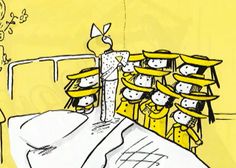Thursday
Yesterday I spent the day in a hospital as Julia had her gall bladder removed. The operation was successful, and when she showed me her scars, I flashed back on one of my favorite books from my childhood. I had my parents read it to me so many times that I had it memorized.
Ludwig Bemelmans’s “Madeline” is about a little girl in a convent school who comes down with appendicitis and has to be rushed to the hospital in the middle of the night. While the “twelve little girls” at the school do everything in “two straight lines,” Madeline is a rebel and often does her own thing:
[T]he smallest one
was Madeline.
She was not afraid
of mice-
she loved winter,
snow, and ice.
To the tiger in the zoo
Madeline just said,
“Pooh-pooh,”
and nobody knew so well
how to frighten Miss Clavel.
Contracting appendicitis is another ways that Madeline stands out, although in this case it undermines her self-sufficiency:
In the middle of one night
Miss Clavel turned on the light
and said, “Something is not right!”
Little Madeline sat in bed,
cried and cried; her eyes were red.
And soon after Dr. Cohn
came, he rushed out to the phone
and he dialed: DANton-ten-six-
“Nurse,” he said, “it’s an appendix!”
As a child, I remember being fascinated by Madeline’s bed and by her hospital room:
Madeline soon ate and drank.
On her bed there was a crank,
and a crank on the ceiling had the habit
of sometimes looking like a rabbit.
Today’s hospital beds, I can report, have electronic cranks and a host of other features. In the standardized and anodyne hospital rooms, however, there are no interesting ceiling cracks.
What most stood out to me as a child, however, is the moment when Madeline shows off her scar. All eyes are on her:
One nice morning Miss Clavel said–
“Isn’t this a fine-
day to visit
Madeline.”
VISITORS FROM TWO TO FOUR
read a sign outside her door.
Tiptoeing with solemn face,
with some flowers and a vase,
in they walked and then said, “Ahhh,”
when they saw the toys and candy
and the dollhouse from Papa.
But the biggest surprise by far–
on her stomach
was a scar!
According to my mother, my two-year-old self was delighted by that final stanza and I would excitedly announce, “On her tomach was a car.” I must have been excited, even though I didn’t know what scars were, that Madeline had triumphantly overcome adversity and everyone was admiring her for doing so.
Well, Julia has three scars, held together by super glue (which apparently they now use in place of stitches). She too has triumphantly overcome diversity.
Julia travels to Atlanta next week to begin taking care of our three granddaughters and will have to be very careful about lifting and straining. Like Madeline’s classmates, I suspect that Esmé and Etta will be fascinated by the scars. Unlike those classmates, however, I doubt if they will long to have scars of their own:
In the middle of the night
Miss Clavel turned on her light
and said, “Something is not right!”
And afraid of disaster
Miss Clavel ran fast and faster,
and she said, “Please children do-
tell me what is troubling you?”
And all the little girls cried, “Boohoo,
we want to have our appendix out too!”
Did I love the book because it captures both a child’s restless nights and the need for assurance that adults will be there if things go wrong? Whatever the case, I remember being comforted by Miss Clavel’s final reassurance:
“Good night, little girls!
Thank the lord you are well!
And now go to sleep!”
said Miss Clavel.
And she turned out the light–
and closed the door–
and that’s all there is–
there isn’t any more.


